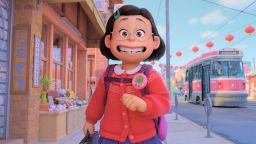Editor’s Note: Holly Thomas is a writer and editor based in London. She is morning editor at Katie Couric Media. She tweets @HolstaT. The opinions expressed in this commentary are solely those of the author. View more opinion on CNN.
The 2023 Oscar nominations are in, and movie fans are appraising the list with their usual zeal. For every exaltation over “Everything Everywhere All At Once,” there’s a sigh of dismay over Viola Davis’ best actress snub, the erasure of “Till” and “Decision to Leave,” and the all-male best director lineup.

Among the more niche upsets, “Guillermo del Toro’s Pinocchio,” by far the gnarliest and most beautiful of 2022’s glut of adaptations, did not, as many hoped, pick up a nomination for best picture. It’s languishing instead in the animated feature film category, alongside “Marcel the Shell with Shoes On,” “Puss in Boots: The Last Wish,” “The Sea Beast” and “Turning Red”.
It’s understandable why some viewers are reading the choice as a demotion. Audiences, especially adult ones, can be shallow, and voices, even famous ones, don’t automatically command the level of attention that buccal-fat-free celebrity faces do. Absent the gloss that Tom Cruise brings to “Top Gun: Maverick,” or the satisfaction of watching Austin Butler pull off Elvis’s hip thrust, animation is a tougher sell.
It’s a shame. Animation — and this year’s Oscar roundup in particular — has tons to recommend it. As an art form, it’s a wild card, offering creators a blank slate that live-action does not.
It requires both phenomenal imagination and incredible patience. The balance of exposition and metaphor, of what is compelling yet age-appropriate, is far harder to strike when storyboards are not limited by real sets, costumes, actors and physics.
Add to that the complexity of making movies that will both capture a child’s attention and enchant the adults who will inevitably have to watch with them and it’s hard to concoct a more demanding task.
It’s not always the case, but this year’s nominees for best animated feature are all children’s films. The fact that “Guillermo del Toro’s Pinocchio,” a sinister fantasy set in fascist Italy during the interwar period and World War II, is counted among the best of these should be a cause for celebration.
“Puss in Boots: The Last Wish” is the first movie in the “Shrek” franchise to stand on its merits without an outsize dependence on Smash Mouth’s back catalog. “Turning Red” is the first kid-friendly film ever to tackle menstruation in a way that’s designed to be enjoyable (“Period. End of Sentence,” which picked up the award for best documentary short in 2019, was a very worthy, but decidedly un-fun watch).

“Marcel the Shell with Shoes On” is the first live-action-animation hybrid to be considered for the award, and “The Sea Beast,” continuing the tradition of the “How to Train Your Dragon” series, elevates an otherwise predictable morality tale with lavish visuals and echoes of “Moby-Dick.”
If all this sounds insufficiently impressive, please bear in mind that writing for children is hard. It’s arguably harder than writing for adults. As Roald Dahl once explained, in order to do it well, you must have experience, but by the time you’ve acquired it, a chasm divides you and your audience.
Communication is stymied by default because you no longer speak the same language, so writing stories that excite them requires a rare deftness of humor and imagination. Kids are also prone to revisit their favorite books again and again, so the work must withstand meticulous scrutiny. All this is true of children’s films too, and working in animation adds further layers of sophistication.

Animating stories means working in unknown dimensions, fashioning realities from the ground up. You’re not just creating characters, you’re creating the creatures that play them. As in live-action, you must choose a color palette, but you also have to pick a medium in which to paint.
This decision has huge implications for both the visuals and the production. “The Sea Beast” opted to splash out on water shots, which are infamously expensive if you’re working in CGI. The result is exquisite panoramics and lustrous action scenes as the monsters surge out of the waves.
Guillermo Del Toro’s stop-motion “Pinocchio” took more than 1,000 days to shoot, and that time and attention are evident in every shadow and crevice as the stringless puppet dances creakily across the screen. What could make more sense than stop motion for a story about breathing life into an inanimate object? No matter how laboriously honed, the figures remain, deliberately, unnatural.
This otherworldliness also allows animated films for kids to veer far darker than their live-action counterparts. The plot of Pinocchio is infamously bleak, but even its lighter competitors hit notes that it’d be unwise to attempt without some artistic distance.
“Marcel the Shell with Shoes On” concerns a tiny shell who lives in an Airbnb with his grandmother. His whimsical mission to find the rest of his family leans more adorable than tragic because he is a crustacean in sneakers, but even the most obtuse child will register the message that we should treasure our loved ones while we can.
Kids can be intense empaths, but they are also deeply ignorant of the harsher realities of the grown-up world. Fiction offers a natural framework as they build schema around difficult subjects, but such steps must be taken in careful increments. The gold standard remains the death of Bambi’s cartoon mother, many people’s first lesson that grief is inevitable, but survivable.
In animation, striking a balance between what to include and what to leave out is all the more challenging because the creative scope is limitless. There is a reason why the classics remain classics; why in “Bambi” — released the better part of a century ago, in 1942 — we hear a gunshot, but see no body.
About half an hour into “Guillermo del Toro’s Pinocchio,” our wooden protagonist, who’s doing some handiwork in the local church with his creator Geppetto, has a question.
“Papa,” he says. “There’s something I don’t understand.” He points to the carved figure of Christ hanging above the altar.
“Why do they like him, and not me? He’s made of wood too.”
Even by the standard of cinema’s preeminent lapsed Catholic, the exchange packs subtext. The weight of parental expectations, the hypocrisy of Geppetto’s fascist neighbors, Pinocchio’s own innocence — and hanging quite literally over it all, the film’s central themes of death and reincarnation — are captured in a handful of words and a few sumptuous images.
It’s signature del Toro: Float like a butterfly, sting like a bee. Nothing about it is less powerful for having been rendered in stop motion. In fact, the opposite is true. The staggered movements and painterly backdrop soften the edges of a scene that in live-action would be unbearably heavy-handed. It’s elegant, it sings. It deserves an Oscar.






